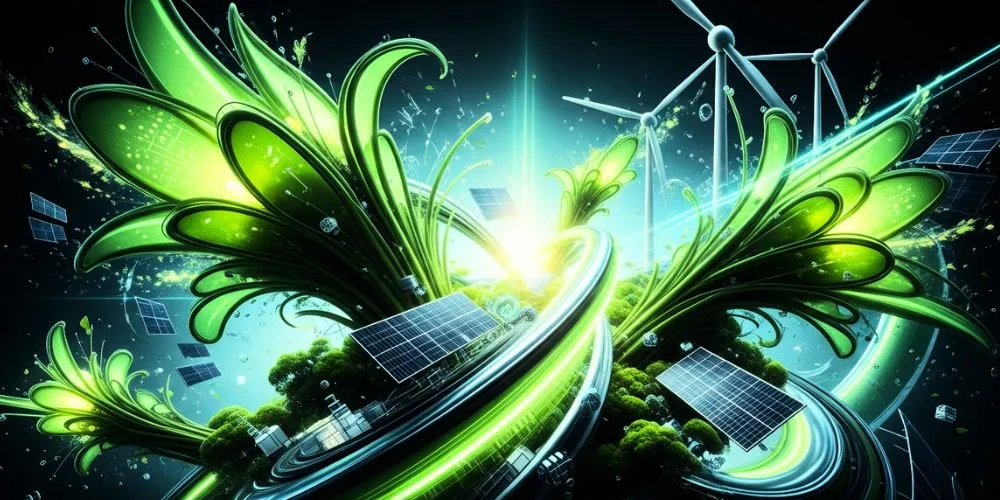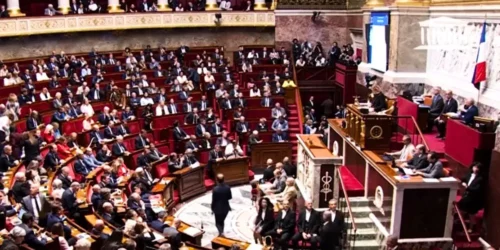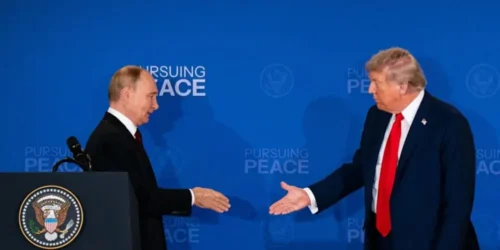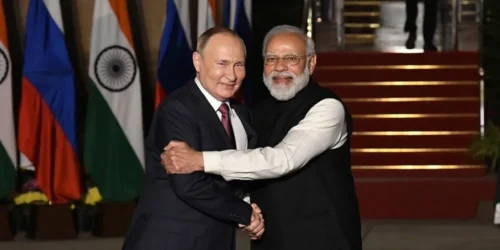For decades, “green technology” existed in a well-meaning but dusty corner of the public imagination. It was the stuff of science fairs and off-grid desert communes. It conjured images of clunky, handmade solar panels on the roofs of sandal-wearing idealists, or earnest PSAs about recycling. It was a noble pursuit, certainly, but it was niche. It was a sacrifice. It was, above all, expensive. There was a “green premium”—a hefty price one paid for the luxury of a clear conscience. For the pragmatic, hard-nosed world of global industry and finance, it was a rounding error, a corporate social responsibility line item, a conversation for another day. That day has arrived. And it looks nothing like we thought it would.
The story of green technology in the 21st century is not one of gentle, incremental progress. It is the story of a ferocious, disruptive, and breathtakingly rapid economic transformation. It is a quiet revolution that has moved out of the commune and into the boardroom, out of the science fair and onto the floors of global stock exchanges. The “green premium” is vanishing, and in many sectors, it has inverted into a “green discount.” The conversation is no longer about sacrifice; it’s about opportunity. It’s not about saving the planet as an act of charity; it’s about re-engineering our civilization as an act of economic necessity and competitive survival.
This is a case study of that revolution. We will not just list technologies; we will dissect the powerful, interconnected forces that turned a fringe movement into the next great industrial paradigm. We will explore how the relentless physics of the learning curve, the focused pressure of policy, and a profound shift in corporate consciousness created a perfect storm of disruption. We will journey to the new frontiers of this revolution—from deserts blooming with green hydrogen plants to intelligent energy grids that think like a neural network.
But we will also confront the uncomfortable truths. This is not a utopian fable. The green transition is creating a complex web of geopolitical tensions, resource bottlenecks, and social challenges. To understand green technology is to understand this messy, brilliant, and dangerous new world we are building. This is the story of the great rewiring of our planet—a project more ambitious than the moon landing, more complex than the dawn of the internet, and more consequential than anything humanity has ever attempted before.
The Age of the Green Premium – Why the First Wave Stalled
To appreciate the speed of the current revolution, we must first understand why it took so long to start. The first wave of green technology, which peaked during the oil shocks of the 1970s and ebbed and flowed for the next three decades, was defined by one crushing reality: cost.
The Burden of the Idealist
Imagine it’s 1980. You’re an environmentally conscious homeowner who wants to install solar panels on your roof. The panels themselves are monstrously inefficient, converting only a tiny fraction of the sun’s energy into usable electricity. They are handmade, delicate, and absurdly expensive. The cost per watt of solar power is around $100 (in today’s money). To power a modest home would cost more than the house itself. You would also need a massive bank of lead-acid batteries, an inverter to convert DC power to AC, and a deep understanding of electrical engineering.
Meanwhile, the alternative—grid electricity generated by a coal or gas power plant is cheap, reliable, and effortless. You flip a switch, and the lights come on. The choice was stark. To go green was an act of profound personal commitment and financial sacrifice. You weren’t just a consumer; you were a pioneer, an activist. The technology worked, but the economics were impossible for all but the most dedicated and wealthy idealists.
This was the era of the “green premium.” It was the extra cost that a consumer or a company had to pay to choose the environmentally friendly option over the conventional, fossil-fuel-powered one. For solar power, electric vehicles, wind turbines, and sustainable materials, this premium was not a few percentage points; it was often an order of magnitude.
The Corporate Cold Shoulder
In the corporate world, this premium was a non-starter. The mandate of a public company was to maximize shareholder value. Intentionally choosing a more expensive, less efficient technology was seen as a dereliction of that duty. Green initiatives were confined to the “Corporate Social Responsibility” (CSR) department—a cost center designed to generate good PR, rather than re-engineering the core business.
A manufacturing company might install a small solar array in its parking lot for a photo-op. However, the cheapest electricity from the local utility would still power the factory itself. An airline might invest in carbon offsets, but it would fight tooth and nail against any regulation that mandated more expensive, sustainable aviation fuels. The logic of the market was clear and unforgiving: cost is king, and fossil fuels were the undisputed sovereign.
The first wave of green technology was trapped in a vicious cycle. Because the market was small, there were no economies of scale. Because there were no economies of scale, the costs remained high. Due to the high costs, the market remained small. It was a technological curiosity, a moral statement, but it was not yet a serious economic force. It lacked the catalyst that could break the cycle and unleash its true potential.
The Tipping Point – The Three Forces That Changed the World
Sometime in the late 2000s and early 2010s, the ground began to shift. The vicious cycle began to stutter and then spin in the opposite direction, becoming a virtuous one. This wasn’t due to a single breakthrough, but the convergence of three powerful, mutually reinforcing forces that shattered the old paradigm.
The Relentless Physics of the Learning Curve
In 1936, an aeronautical engineer named Theodore Wright observed a simple, powerful phenomenon: for every doubling of total aircraft production, the labor cost required to produce the next plane fell by a consistent percentage. This phenomenon became known as Wright’s Law, also referred to as the “learning curve.” It’s the simple idea that the more you make something, the better and cheaper you get at making it. You discover efficiencies, improve manufacturing processes, and innovate on materials.
For decades, this law was applied to everything from cars to microchips. But in the 2000s, it took hold of green technology with a ferocity that stunned even its most optimistic proponents. The poster child for this effect is the solar photovoltaic (PV) panel.
- In the 1980s, as we saw, the cost was astronomical.
- By the early 2000s, a combination of research, government incentives (particularly in Germany), and the entry of Chinese manufacturing giants had begun to dramatically increase the scale of global production.
- As production doubled, and then doubled again, and again, Wright’s Law kicked in. The cost of solar panels began to plummet.
The numbers are staggering. Between 2010 and 2020, the price of solar PV modules decreased by over 90%. A technology that was once more expensive than nuclear power became, in many parts of the world, the cheapest form of new electricity generation humanity has ever created. The same learning curve effect was happening in wind turbines, which grew larger and more efficient, and in lithium-ion batteries, the core technology for electric vehicles and grid storage.
This wasn’t magic. It was the result of thousands of small innovations in materials science, manufacturing automation, and supply chain logistics. But the effect was revolutionary. It fundamentally broke the economic barrier of the green premium. For the first time, a company or a country could choose the green option not because it was the right thing to do, but because it was the smart thing to do. The economics had flipped.
Policy as a Powerful Accelerator
While the learning curve provided the engine for cost reduction, government policy provided the fuel and the steering. Skeptics often dismiss green technology as a product of subsidies, but this misses the point. Strategic policy was essential for creating the initial market scale needed to kickstart the learning curve.
- Global Signals: The 2015 Paris Agreement was a landmark moment. For the first time, nearly every nation on Earth agreed on the necessity of decarbonization. This sent a powerful, long-term signal to global capital markets, corporations, and investors: the future is low-carbon. The direction of travel was now clear, even if the path was complex.
- National Industrial Policies: Ambitious national policies created the crucial early markets. Germany’s “Feed-in Tariff” system guaranteed a profitable price for renewable energy, leading to a massive solar boom. China declared renewable energy a strategic industry and poured immense state resources into building a world-dominating manufacturing base. The U.S. utilized Investment Tax Credits (ITCs) and Production Tax Credits (PTCs) to mitigate the risk of private investment in solar and wind projects.
- Regulations and Mandates: Policies such as vehicle emissions standards in Europe and Renewable Portfolio Standards in U.S. states have forced utilities and automakers to either innovate or face penalties. These regulations created a guaranteed demand for green technologies, further accelerating their deployment and driving down costs for everyone.
Policy served as a powerful catalyst, bridging the gap between the high costs of the early days and the lower costs of the future. It created a protected space for the learning curve to work its magic.
The Corporate and Financial Awakening
The final, and perhaps most crucial, force was a profound shift in the mindset of the corporate and financial worlds. The conversation about climate change moved from the CSR department to the Chief Financial Officer’s office and the main stage at Davos. This awakening happened for three key reasons:
- Risk Mitigation: The financial world began to view climate change not as a distant environmental issue, but as a clear and present financial risk. Larry Fink, the CEO of BlackRock, the world’s largest asset manager, began writing annual letters to CEOs stating that “climate risk is investment risk.” This was a seismic event. Investors began to worry about “stranded assets”—the idea that a company’s coal mines, oil reserves, or fleet of gasoline-powered vehicles could become worthless in a decarbonizing world.
- The Rise of ESG: The concept of Environmental, Social, and Governance (ESG) investing exploded. A new generation of investors, ranging from massive pension funds to individual retail traders, has begun demanding that their money be invested in sustainable, responsible companies. Trillions of dollars in global capital began to flow towards companies with strong ESG credentials and away from climate laggards. Access to capital—the lifeblood of any business—was now increasingly tied to a company’s climate strategy.
- The Pull of Opportunity and Pressure: As the cost of green technologies plummeted, savvy business leaders began to see opportunity instead of obligation. A company could lower its energy bills, insulate itself from volatile fossil fuel prices, and attract top talent by embracing sustainability. Simultaneously, pressure from consumers and employees, particularly Millennials and Gen Z, grew immense. People wanted to work for and buy from brands that were part of the solution, not the problem.
The convergence of these three forces—plummeting costs, accelerating policy, and a rewired financial system—created the tipping point. The old excuses vanished. Green technology was no longer a costly sacrifice. It was a technologically mature, economically viable, and strategically essential component of 21st-century business. The revolution had begun in earnest.
Case Studies from the New Frontier – The Revolution in Practice
The green technology revolution is not a monolithic event. It is a sprawling, diverse ecosystem of innovation that touches every sector of the global economy. To understand its true scope, we must move beyond the familiar images of solar panels and wind turbines and explore the cutting edge.
The Desert Bloom – Green Hydrogen and the Decarbonization of Heavy Industry
The Problem: Solar and wind power are fantastic for generating clean electricity. But electricity only accounts for about 20% of global emissions. What about the other 80%? The “hard-to-abate” sectors, such as steel manufacturing, long-haul shipping, and chemical production, require immense heat and chemical feedstocks that cannot be easily provided by plugging into the grid.
The Technology: Enter green hydrogen. The concept is simple, yet revolutionary. You take renewable electricity (from massive solar or wind farms) and use it to power an electrolyzer, a device that splits water (H₂O) into its constituent parts: hydrogen and oxygen. The resulting “green” hydrogen is a clean, energy-dense fuel. When you burn it, the only byproduct is water. It can be used to create the intense heat needed for steelmaking, synthesized into ammonia to power cargo ships, or used as a long-term storage medium for renewable energy.
The Frontier in Practice: The NEOM project in Saudi Arabia is a prime example of this new frontier. In the sun-scorched deserts of the northwest, a consortium of international companies is building one of the world’s largest green hydrogen plants. The scale is almost unimaginable. The project involves building 4 gigawatts of new solar and wind capacity—enough to power a small country—dedicated solely to producing 650 tons of green hydrogen per day. The total investment is over $5 billion.
This is not a small-scale pilot. This is green technology at an industrial, nation-building scale. Saudi Arabia, a kingdom built on petrodollars, is making a massive bet that green hydrogen will be the “new oil” of the 21st century. Similar giga-projects are being developed in Australia, Chile, and Oman—places with abundant sun and wind. They are re-engineering their national economies to become the clean energy powerhouses of the future. This is what the great rewiring looks like: turning empty deserts into the engine rooms of the next industrial revolution.
The Neural Grid – Smart Grids and the Digitization of Energy
The Problem: The biggest challenge of solar and wind power is their intermittent nature. The sun doesn’t always shine, and the wind doesn’t always blow. The traditional electricity grid was built for a world of predictable, centralized power plants (coal, gas, nuclear) that could be turned on and off at will. It’s a “dumb” system, a one-way street where power flows from the plant to the consumer. Flooding this dumb grid with volatile, decentralized renewable energy is a recipe for blackouts and instability.
The Technology: The solution involves making the grid smart. A “smart grid” is a two-way, digitized network that uses sensors, AI, and advanced software to manage the flow of energy in real-time. It’s the “internet of energy.”
- Grid-Scale Batteries: Massive lithium-ion battery installations can store excess solar power during the day and release it in the evening when demand peaks.
- Demand Response: Smart software can communicate with appliances in homes and businesses, subtly shifting their energy consumption to times when renewable power is abundant and cheap. Your smart thermostat might pre-cool your house at 2 PM when solar is plentiful, reducing the strain on the grid at 7 PM.
- AI-Powered Forecasting: Sophisticated AI algorithms can now predict weather patterns and energy demand with remarkable accuracy, enabling grid operators to proactively balance supply and demand from thousands of decentralized sources.
The Frontier in Practice: Ørsted, a Danish company, is a fascinating case study in corporate transformation. A few decades ago, it was DONG Energy (Danish Oil and Natural Gas), a state-owned company that focused on fossil fuels. Today, it has sold off all its oil and gas assets and is the world’s largest developer of offshore wind farms. But its true innovation lies in how it integrates this power. Ørsted uses a sophisticated AI platform to manage its fleet of wind farms, optimizing turbine performance and bidding its power into energy markets in real-time. They are pioneers in combining large-scale renewable generation with the digital intelligence needed to make it reliable, transforming a volatile resource into a dependable, 24/7 power source.
The Urban Mine – The Circular Economy and the End of Waste
The Problem: Our current industrial model is linear: “take, make, waste.” We extract raw materials from the earth, manufacture products, and then dispose of them in a landfill at the end of their useful life. This is not only environmentally destructive but also economically foolish. Landfills are often filled with valuable materials, including copper, aluminum, and rare earth metals.
The Technology: The Circular Economy is a radical rethinking of this model. It’s a system designed to minimize waste and maximize the use of materials for as long as possible. This involves a suite of new technologies and business models.
- Advanced Sorting and Recycling: AI-powered robots can now sort complex waste streams with incredible speed and accuracy, recovering valuable materials that were previously lost.
- Chemical Recycling: New chemical processes can break down plastics into their basic molecular components, allowing them to be reborn as virgin-quality materials, a true closed loop.
- Product as a Service: Companies are shifting from selling products to selling services. Philips, for example, now offers “Lighting as a Service,” where they retain ownership of the light fixtures and are responsible for their maintenance, upgrading, and end-of-life recycling. This incentivizes them to design durable, easily repairable products.
The Frontier in Practice: Redwood Materials, a startup founded by ex-Tesla CTO JB Straubel, is building what it calls “urban mines.” They are creating a massive, closed-loop supply chain for electric vehicle batteries in the United States. They collect old EV batteries and scrap material from battery factories, then use a combination of hydrometallurgy and other advanced processes to recover critical materials like lithium, cobalt, and nickel. They then supply these recycled, high-purity materials right back to battery manufacturers. This reduces the need for destructive new mining, shortens supply chains, and insulates the U.S. auto industry from volatile, geopolitically risky commodity markets. It’s a perfect example of how green technology can simultaneously be an environmental solution and a powerful business strategy.
The Uncomfortable Truths – Navigating the Green Maze
To paint the green transition as a seamless, utopian journey would be a disservice to its complexity. The great rewiring is a monumental undertaking, fraught with its own set of profound challenges and uncomfortable truths. Ignoring them is not an option.
The New Geopolitics of a Green World
We are not ending our reliance on natural resources; we are shifting it. The geopolitics of oil shaped the 20th century. The geopolitics of critical minerals will shape the 21st century.
- Lithium: Essential for EV batteries, a majority of the world’s reserves are concentrated in the “Lithium Triangle” of Argentina, Bolivia, and Chile.
- Cobalt: Another critical battery component, with over 70% of global production coming from the politically unstable Democratic Republic of Congo.
- Rare Earth Elements: Vital for the powerful magnets in wind turbines and EV motors. China currently dominates not just the mining but, more importantly, the processing of these materials, giving it a powerful strategic chokepoint.
The transition to green technology does not free us from geopolitical competition; it simply redraws the map. The race to secure these new supply chains is already leading to intense rivalry between the U.S., Europe, and China. Nations that control these minerals will wield immense power, and nations that don’t will be vulnerable.
The Fragility of the Grid and the Burden of Land
Integrating massive amounts of renewable energy is a staggering engineering challenge. The infamous “duck curve” in California illustrates the problem perfectly. During the middle of the day, a surge of solar power floods the grid, driving prices to zero or even negative. As the sun sets, solar power vanishes, and demand spikes, requiring a massive, near-instantaneous ramp-up of other power sources. Managing this requires a multi-trillion-dollar investment in energy storage, smart grid technology, and new transmission lines.
Furthermore, renewable energy is land-intensive. A massive solar farm or wind installation can cover thousands of acres, potentially creating conflicts with agricultural land, wildlife habitats, and local communities. The “Not In My Backyard” (NIMBY) phenomenon is a significant obstacle to building the vast infrastructure required for this transition.
The Question of a “Just Transition”
The green revolution, like all industrial revolutions, will create winners and losers. While new jobs are being created in solar installation and battery manufacturing, entire communities built around the fossil fuel economy—from coal miners in Appalachia to oil rig workers in Texas—face an uncertain future.
A “Just Transition” is the principle that the benefits of a green economy should be shared widely and that the costs should not be borne disproportionately by vulnerable workers and communities. This is an immense social and political challenge. It requires massive investment in worker retraining programs, social safety nets, and economic development in former fossil fuel regions. Without a commitment to justice and equity, the green transition risks creating deep social divisions and a powerful political backlash that could slow or even derail the entire project.
Conclusion: The Cathedral Builders of the 21st Century
The story of green technology is the defining economic and engineering saga of our time. It is a story of how a fringe ideal, powered by the relentless logic of the learning curve and guided by strategic policy, grew into a global industrial force. We have moved from an era of sacrifice to an era of innovation, from a conversation about cost to a race for opportunity. The great rewiring is underway. It is happening in the deserts of Arabia, in the offshore wind farms of the North Sea, and in the “urban mines” of our cities. It is a project of breathtaking scale and complexity, driven by a new generation of scientists, engineers, entrepreneurs, and financiers.
But the journey is far from over, and its success is not guaranteed. The path is littered with immense challenges—geopolitical rivalries, technical hurdles, and profound questions of social justice. Navigating this green maze will require not just technological brilliance, but also political wisdom and a deep sense of shared purpose.
In the Middle Ages, master builders began constructing cathedrals that they knew they would never see completed in their lifetimes. They laid the foundations and raised the first walls, trusting that future generations would continue the work. The great rewiring of our civilization is a project of similar magnitude. We are the first generation of these new cathedral builders. We are laying the foundations of a cleaner, more resilient, and more sustainable global economy. The work is challenging, the path is uncertain, and the final form of the structure remains unknown. But for the first time in history, the blueprints are on the table, the tools are in our hands, and the work has finally, truly, begun.













